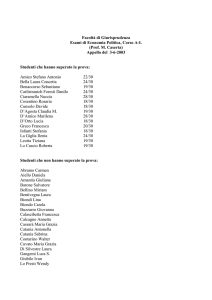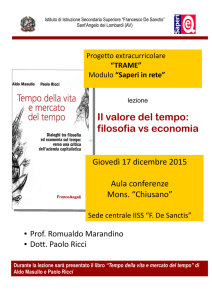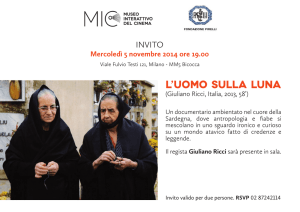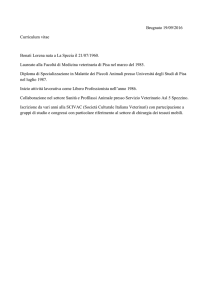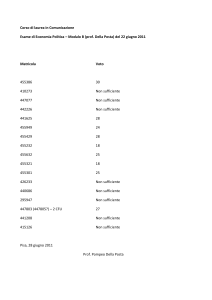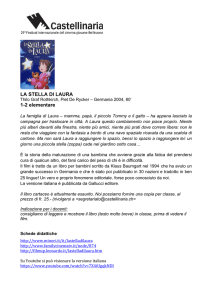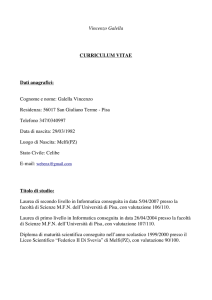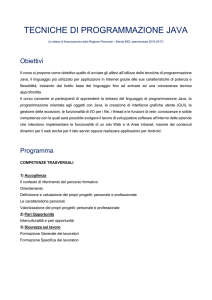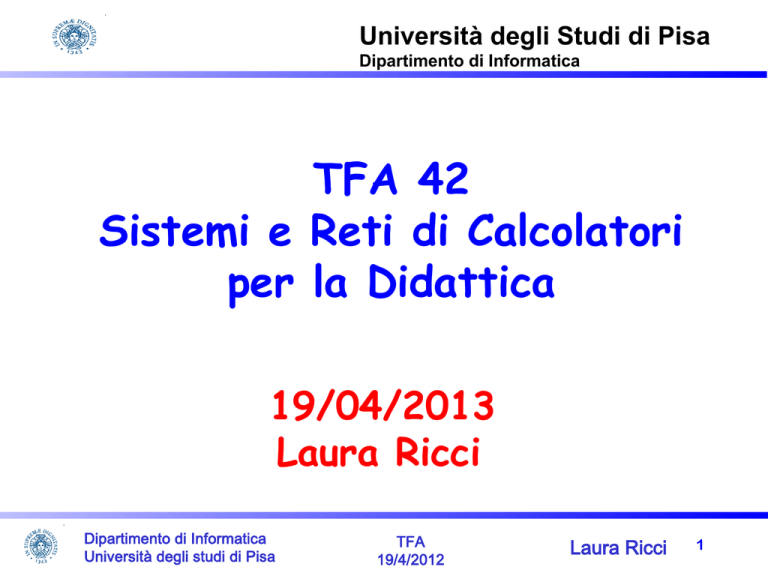
Università degli Studi di Pisa
Dipartimento di Informatica
TFA 42
Sistemi e Reti di Calcolatori
per la Didattica
19/04/2013
Laura Ricci
Dipartimento di Informatica
Università degli studi di Pisa
TFA
19/4/2012
Laura Ricci
1
“COMPITO PER LE VACANZE”
•
progettare altre esperienze di laboratorio che consentano la
sperimentazione di qualche aspetto relativo ai protocolli di rete sviluppati
nelle lezioni teoriche
•
con riferimento a JAVA, alcuni esempi:
•
altri esempi anche in riferimento ad altri linguaggi/ambienti?
verifica che il protocollo UDP non implementa controllo di flusso
protocollo HTTP
gestione URL
…...???
Dipartimento di Informatica
Università degli studi di Pisa
TFA
19/4/2012
Laura Ricci
2
LABORATORIO: ACCEDERE A RISORSE IN RETE
•
Prerequisiti:
•
Scopo dell'esercizio:
Struttura di una URL
Identificare risorse in Internet
capire come è formata una URL
leggere la risorsa individuata da una URL
risorse considerate
pagine web
file
Dipartimento di Informatica
Università degli studi di Pisa
TFA
19/4/2012
Laura Ricci
3
LABORATORIO: ACCEDERE A RISORSE IN RETE
•
•
•
•
Utilizzare JAVA come ambiente di programmazione
leggere la risorsa individuata da una URL
se la risorsa è una pagina web, scaricare il contenuto della pagina
analizzare l'HTML della pagina
public static void main(String args[])
{ try
{ new ProvaURL("http://www.unipi.it"); }
catch(MalformedURLException ex)
{ ex.printStackTrace(); }
catch(IOException ex)
{
ex.printStackTrace(); }
}
Dipartimento di Informatica
Università degli studi di Pisa
TFA
19/4/2012
Laura Ricci
4
LABORATORIO: ACCEDERE A RISORSE IN RETE
import java.io.DataInputStream;
import java.io.IOException;
import java.io.InputStream;
import java.net.MalformedURLException;
import java.net.URL;
import java.net.URLConnection;
public class ProvaURL
{
public ProvaURL(String urlStr) throws MalformedURLException,
IOException
{
Dipartimento di Informatica
Università degli studi di Pisa
TFA
19/4/2012
Laura Ricci
5
LABORATORIO: ACCEDERE A RISORSE IN RETE
URL url = null;
url = new URL(urlStr);
URLConnection urlConnection;
urlConnection = url.openConnection();
InputStream urlStream;
urlStream = url.openStream();
String type = null;
type = urlConnection.getContentType();
System.out.println(type);
if(type==null)
return;
else if( type.compareTo("text/html; charset=utf-8") != 0 )
return; }
Dipartimento di Informatica
Università degli studi di Pisa
TFA
19/4/2012
Laura Ricci
6
LABORATORIO: ACCEDERE A RISORSE IN RETE
StringBuffer content;
content = new StringBuffer();
DataInputStream html;
html = new DataInputStream(urlStream);
String line;
while ((line = html.readLine()) != null)
{ content.append(new String(line));
content.append('\n');
}
System.out.print(content);
}
Dipartimento di Informatica
Università degli studi di Pisa
TFA
19/4/2012
Laura Ricci
7
LABORATORIO: ACCEDERE A RISORSE IN RETE
Da osservare:
•
Quando un server invia un documento ad un client (Ad esempio ad un
browser), invia anche un header HTTP, content-type
•
Content type: tipo dei dati contenuti nel documento
•
Documento di tipo testo (text/HTML)
•
Parametro charset in the HTTP header specifica la codifica dei
caratteri contenuti nel documento
Dipartimento di Informatica
Università degli studi di Pisa
TFA
19/4/2012
Laura Ricci
8
LABORATORIO: ACCEDERE A RISORSE IN RETE
Cosaviene stampato.....
text/html; charset=utf-8
<!DOCTYPE html PUBLIC "-//W3C//DTD XHTML 1.0 Strict//EN"
"http://www.w3.org/TR/xhtml1/DTD/xhtml1-strict.dtd">
<html xmlns="http://www.w3.org/1999/xhtml" xml:lang="it" lang="it">
<head>
<base href="http://www.unipi.it/" /><!--[if lte IE 6]></base><!
[endif]-->
<meta http-equiv="content-type" content="text/html; charset=utf-8" />
<meta name="robots" content="index, follow" />
<meta name="keywords" content="Università di Pisa, corsi di laurea,
ricerca scientifica, master, dottorati, scuole di specializzazione, servizi
agli studenti" />
<meta name="og:url" content="http://www.unipi.it/" />
<meta name="og:title" content="Home" /> ….......
Dipartimento di Informatica
Università degli studi di Pisa
TFA
19/4/2012
Laura Ricci
9
LABORATORIO: DOWNLOAD DI UN FILE
import java.io.*;
import java.net.*;
public class DownLoadFromURL {
public static void main(String[] args) {
try {
URL url = new URL("http://www.bluej.org/tutorial/tutorial-201.pdf");
// The server thinks this request is from an Opera browser!
String userAgent = "Opera/9.63 (Windows NT 5.1; U; en)Presto/2.1.1";
System.out.println("Downloading ...");
downloadFromUrl(url, "tutorial.pdf", userAgent);
System.out.println("OK");
} catch (Exception e) {
System.err.println(e); }
}
Dipartimento di Informatica
Università degli studi di Pisa
TFA
19/4/2012
Laura Ricci
10
LABORATORIO: DOWNLOAD DI UN FILE
public static void downloadFromUrl(URL url, String localFilename, String userAgent)
throws IOException
{
InputStream is = null;
FileOutputStream fos = null;
try { URLConnection urlConn = url.openConnection();
if (userAgent != null) {
urlConn.setRequestProperty("User-Agent", userAgent); }
is = urlConn.getInputStream();
fos = new FileOutputStream(localFilename);
byte[] buffer = new byte[4096]; int len;
while ((len = is.read(buffer)) > 0) {
fos.write(buffer, 0, len);
}
} finally { try { if (is != null) { is.close(); }
} finally { if (fos != null) { fos.close();
} }
}
}
Dipartimento di Informatica
Università degli studi di Pisa
TFA
19/4/2012
Laura Ricci
11
LABORATORIO: PROTOCOLLO HTTP
•
Scopo dell'esercizio: analisi del protocollo HTTP
•
Comprensione dei metodi supportati dal protocollo HTTP
•
Esempio: POST
•
Esercizio
Metodo utilizzato per inviare dati al server
Inviare un POST ad un server
Analizzare la risposta del server
Dipartimento di Informatica
Università degli studi di Pisa
TFA
19/4/2012
Laura Ricci
12
PROTOCOLLO HTTP: POST
import java.io.*; import java.net.*;
public class POST {
public static void main(String args[]) throws Exception
{ String nome = "pippo";
//L'URL a cui fare la POST
URL url = new URL("http://www.google.it");
HttpURLConnection connection = (HttpURLConnection) url.openConnection();
connection.setDoOutput(true);
connection.setRequestMethod("POST");
connection.setRequestProperty("Content-Type","application/x-www-formurlencoded");
connection.setRequestProperty("charset", "UTF-8");
connection.setRequestProperty("Content-Length", Integer
.toString(nome.getBytes().length));
connection.setUseCaches(false);
Dipartimento di Informatica
Università degli studi di Pisa
TFA
19/4/2012
Laura Ricci
13
PROTOCOLLO HTTP: POST
DataOutputStream wr=null;
wr = new DataOutputStream(connection.getOutputStream());
wr.writeBytes("nome=" + nome);
wr.flush();
wr.close();
int responseCode = connection.getResponseCode();
System.out.println(responseCode);
}}
Risposta dal server: 405
Server Web “in sola lettura”: gestisce pagine Web statiche, non prevede un input
dall'utente, non consente il metodo POST.
Server Web non abilitato a ricevere dati dall'utente
Dipartimento di Informatica
Università degli studi di Pisa
TFA
19/4/2012
Laura Ricci
14
PERDITA DI PACCHETTI UDP
•
Prerequisiti:
•
Obiettivo della lezione
Conoscenza protocolli UDP e TCP
Tecniche di controllo del flusso
Illustrare differenze tra TCP ed UDP
Scrivere un programma JAVA che dimostri che UDP non
effettua controllod el flusso
Dipartimento di Informatica
Università degli studi di Pisa
TFA
19/4/2012
Laura Ricci
15
PERDITA DI PACCHETTI: SERVER UDP
import java.net.*;import java.io.*;
public class server {
public static void main(String[] args) {
int cd;
try
{
DatagramSocket ds =new DatagramSocket(10001);
InetAddress ia = InetAddress.getByName("LocalHost");
byte [] dataR=new byte[516];
DatagramPacket dpR = new DatagramPacket(dataR,dataR.length);
ds.receive(dpR);
ByteArrayInputStream bis = new ByteArrayInputStream(dpR.getData());
DataInputStream dis = new DataInputStream(bis);
cd=(int)dis.readInt();
System.out.println("client sent to me number "+cd);
Dipartimento di Informatica
Università degli studi di Pisa
TFA
19/4/2012
Laura Ricci
16
PERDITA DI PACCHETTI: SERVER UDP
byte [] data=new byte[516];
ByteArrayOutputStream bos = new ByteArrayOutputStream();
while(cd!=0){
DataOutputStream dos = new DataOutputStream(bos);
try {
dos.writeInt(cd);
} catch (IOException e) { e.printStackTrace();}
data = bos.toByteArray();
DatagramPacket dp = new DatagramPacket(data,data.length,
dpR.getAddress(),dpR.getPort());
ds.send(dp);
bos.reset();
cd--; } }
catch (Exception e) {e.printStackTrace();} }
Dipartimento di Informatica
Università degli studi di Pisa
TFA
19/4/2012
Laura Ricci
17
PERDITA DI PACCHETTI: CLIENT UDP
import java.net.*;import java.io.*;import java.util.*;
public class client {
public static void main(String[] args) {
int number, read_number=0;
Scanner scanner = new Scanner(System.in);
InetAddress ia;
ByteArrayOutputStream bos = new ByteArrayOutputStream();
DataOutputStream dos = new DataOutputStream(bos);
System.out.println("select the nuber to send:");
number=scanner.nextInt();
try {
dos.writeInt(number);
dos.flush();
} catch (IOException e) { e.printStackTrace(); }
Dipartimento di Informatica
Università degli studi di Pisa
TFA
19/4/2012
Laura Ricci
18
PERDITA DI PACCHETTI: CLIENT UDP
byte [] data = bos.toByteArray();
try {
DatagramSocket ds =new DatagramSocket( );
ia = InetAddress.getByName("LocalHost");
DatagramPacket dp = new DatagramPacket(data,data.length, ia,
10001);
ds.send(dp);
byte [] dataR=new byte[516];
DatagramPacket dpR = new DatagramPacket(dataR,dataR.length);
ByteArrayInputStream bis = new ByteArrayInputStream(dpR.getData());
DataInputStream dis = new DataInputStream(bis);
Dipartimento di Informatica
Università degli studi di Pisa
TFA
19/4/2012
Laura Ricci
19
PERDITA DI PACCHETTI: CLIENT UDP
while(number!=0){
try {
Thread.sleep(2000);
} catch (InterruptedException e) { e.printStackTrace(); }
ds.receive(dpR);
read_number=(int)dis.readInt();
System.out.println(""+read_number);
number--;
dis.reset();};
}catch (Exception e) {
e.printStackTrace();
}
}}
Dipartimento di Informatica
Università degli studi di Pisa
TFA
19/4/2012
Laura Ricci
20

